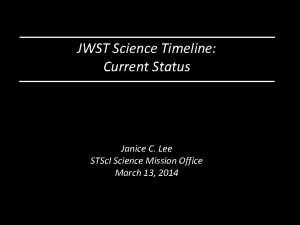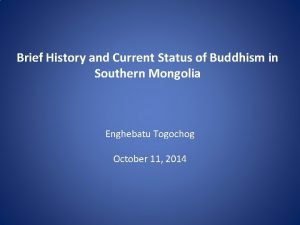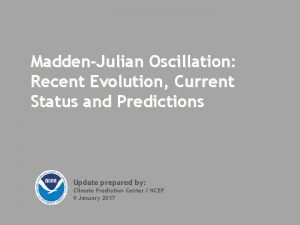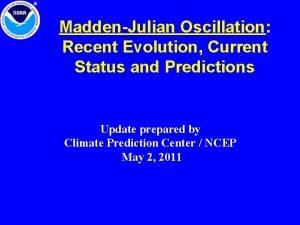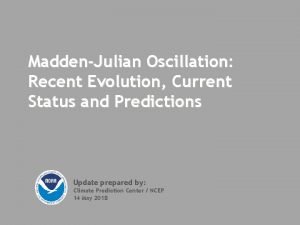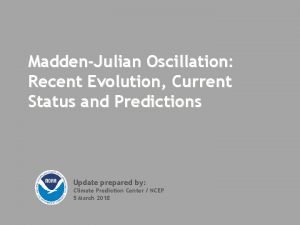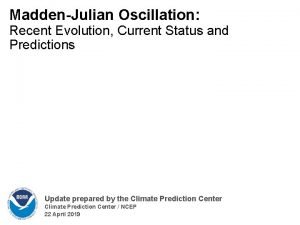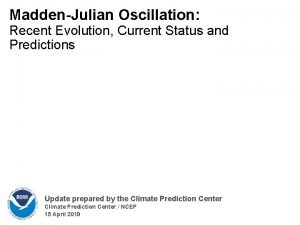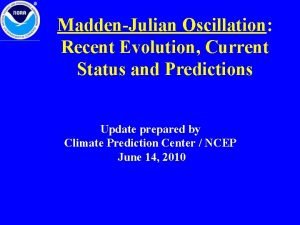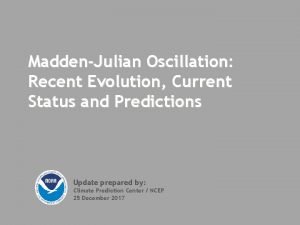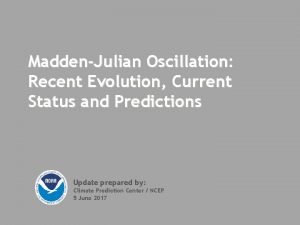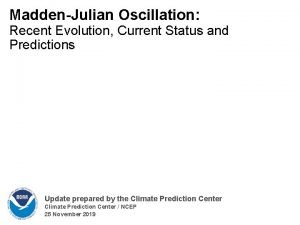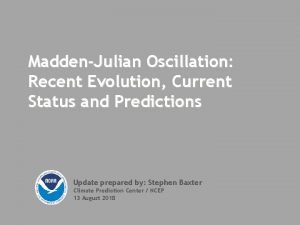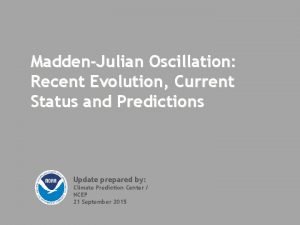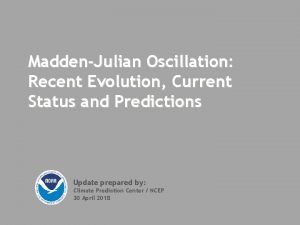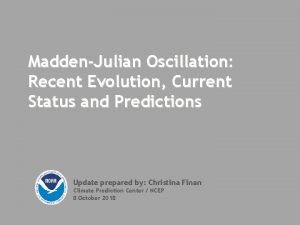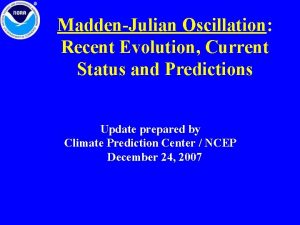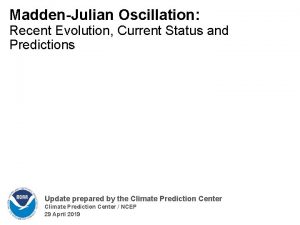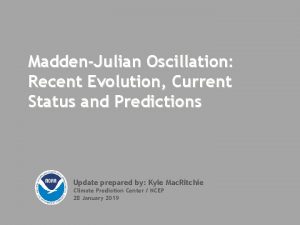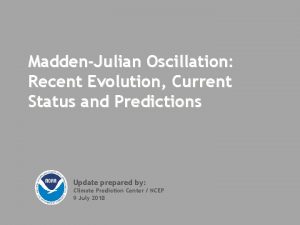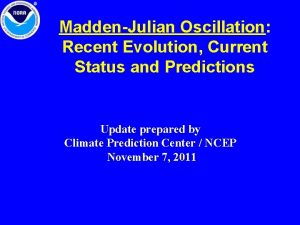MaddenJulian Oscillation Recent Evolution Current Status and Predictions





















- Slides: 21

Madden-Julian Oscillation: Recent Evolution, Current Status and Predictions Update prepared by: Climate Prediction Center / NCEP 16 January 2017

Outline Overview Recent Evolution and Current Conditions MJO Index Information MJO Index Forecasts MJO Composites

Overview While the RMM index indicates weakness of the MJO at present, Hovmöller analyses depict the eastward propagation since late 2016 of an intraseasonal signal presently over the Western Hemisphere. The CPC velocity potential MJO index appears to have done a better job tracking this signal. The low frequency background state continues to influence the tropics and subtropics, with suppressed convection in the Central Pacific and enhanced convection for the Maritime Continent. The subseasonal signal appears to be destructively interfering with the convective signal over the Maritime Continent in recent days. Dynamical model forecasts of the RMM index support an emerging MJO signal in the Western Hemisphere during Week-1 that continues into the Indian Ocean during Week-2. Uncertainty is high late in Week-2 where ensemble mean forecasts support weakening of the MJO, although this could be tied to inconsistent simulated phase speeds cancelling out with one another. Additional potential impacts across the global tropics and a discussion for the U. S. are available at: http: //www. cpc. ncep. noaa. gov/products/precip/CWlink/ghazards/index. php

850 -h. Pa Vector Wind Anomalies (m s-1) Note that shading denotes the zonal wind anomaly C Blue shades: Easterly anomalies Red shades: Westerly anomalies Anomalous cyclonic flow in the North Pacific has been responsible for substantial precipitation in California the last 10 days. C Anomalous westerlies continue across the equatorial Indian Ocean and Maritime Continent, consistent with the lowfrequency state.

850 -h. Pa Zonal Wind Anomalies (m s-1) Westerly anomalies (orange/red shading) represent anomalous west-to-east flow Easterly anomalies (blue shading) represent anomalous east-to-west flow Through early August, high frequency, eastward-propagating modes were observed crossing the Pacific. Since late July, persistent westerly (easterly) anomalies were evident over the eastern Indian Ocean and western Maritime Continent (central and western Pacific) as shown by the red (blue) box at right. These anomalies are low frequency in nature, associated with the negative phase of the Indian Ocean Dipole (IOD), and later, La Niña.

OLR Anomalies – Past 30 days Drier-than-normal conditions, positive OLR anomalies (yellow/red shading) Wetter-than-normal conditions, negative OLR anomalies (blue shading) During the past three 10 -day periods, limited variability was seen in OLR anomalies. This was associated with the dominance of the lowfrequency background state, including supressed convection in the Indian Ocean and Central Pacific, with enhanced convection in the vicinity of the Maritime Continent and associated with the South Pacific Convergence Zone (SPCZ). The most noteworthy intraseasonal activity has been the periodic surges of moisture from the tropical Pacific branching off into the Northern Hemisphere subtropics, impacting western North America and periodically influencing Hawaii.

Outgoing Longwave Radiation (OLR) Anomalies (2. 5ºS - 17. 5º S) Drier-than-normal conditions, positive OLR anomalies (yellow/red shading) Wetter-than-normal conditions, negative OLR anomalies (blue shading) A low frequency state favoring enhanced convection shifting slowly east from the eastern Indian Ocean to the Maritime Continent has been evident since July (green box). Low frequency suppressed convection, tied to building La Niña conditions, has been apparent near the Date Line since August (black box). A fast eastward propagating convective envelope was evident during early September. During most of December, an eastward propagating mode, on the fast end of the MJO phase speed envelope, was apparent across the Indian Ocean and West-Central Pacific.

200 -h. Pa Velocity Potential Anomalies (5ºS - 5ºN) Positive anomalies (brown shading) indicate unfavorable conditions for precipitation Negative anomalies (green shading) indicate favorable conditions for precipitation Through early August, an eastward propagating signal existed, with inactive and active periods of variability apparent. During August, the intraseasonal signal became less coherent, with a weaker and somewhat more stationary anomaly field in place. By late August and early September, there was renewed propagation of the intraseasonal signal. From mid-September to late October, the low frequency signal again dominated the pattern. During November, eastward propagation was observed consistent with MJO activity on the fast end of the intraseasonal spectrum. During December, a more stationary pattern is evident with positive (negative) anomalies observed across the Indian Ocean (Maritime Continent and West Pacific). During the second half of the month, remnant intraseasonal activity is inferred over the Western Hemisphere.

IR Temperatures (K) / 200 -h. Pa Velocity Potential Anomalies Upper-level velocity potential anomalies have congealed towards a wave-1 signature, with enhanced (suppressed) convection over the Americas, Atlantic, and Africa (Indian Ocean, West and Central Pacific). This structure has become coherent enough that persistent negative velocity potential anomalies over the Maritime Continent have waned in recent days. Positive anomalies (brown contours) indicate unfavorable conditions for precipitation Negative anomalies (green contours) indicate favorable conditions for precipitation

200 -h. Pa Vector Wind Anomalies (m s-1) Note that shading denotes the zonal wind anomaly Blue shades: Easterly anomalies Red shades: Westerly anomalies Upper-level westerly anomalies have persisted across the equatorial Pacific and Indian Ocean. Twin anticyclones were apparent in the midlatitudes near 120 E. A A

200 -h. Pa Zonal Wind Anomalies (m s-1) Westerly anomalies (orange/red shading) represent anomalous west-to-east flow Easterly anomalies (blue shading) represent anomalous east-to-west flow After a quiet August, eastward propagation of westerly anomalies was broadly consistent with organized MJO activity during September. In November, anomalous westerlies persisted near the Date Line, though intraseasonal variability associated with the MJO is evident. In late November, easterly anomalies reemerged across the Indian Ocean and Maritime Continent, consistent with the passage of subseasonal activity and the re-alignment of the low frequency base state (red box). Near the end of 2016 a period of westerlies disrupted the low frequency state between 80130 E and continued propagating eastward through the Western Hemisphere.

Weekly Heat Content Evolution in the Equatorial Pacific Oceanic Kelvin waves have alternating warm and cold phases. The warm phase is indicated by dashed lines. Downwelling and warming occur in the leading portion of a Kelvin wave, and upwelling and cooling occur in the trailing portion. Downwelling events were observed through early February, resulting in persistently above-normal heat content from the Date Line to 80 W over that period. An eastward expansion of below average heat content over the western Pacific is evident through April, with widespread negative anomalies building across the Pacific over the course of the spring and summer months. Most recently, upper-ocean heat content anomalies have been low amplitude, consistent with the forecast transition to ENSO-neutral conditions over the coming months.

MJO Index -- Information The MJO index illustrated on the next several slides is the CPC version of the Wheeler and Hendon index (2004, hereafter WH 2004). Wheeler M. and H. Hendon, 2004: An All-Season Real-Time Multivariate MJO Index: Development of an Index for Monitoring and Prediction, Monthly Weather Review, 132, 1917 -1932. The methodology is very similar to that described in WH 2004 but does not include the linear removal of ENSO variability associated with a sea surface temperature index. The methodology is consistent with that outlined by the U. S. CLIVAR MJO Working Group. Gottschalck et al. 2010: A Framework for Assessing Operational Madden-Julian Oscillation Forecasts: A CLIVAR MJO Working Group Project, Bull. Amer. Met. Soc. , 91, 1247 -1258. The index is based on a combined Empirical Orthogonal Function (EOF) analysis using fields of near-equatorially-averaged 850 -h. Pa and 200 -h. Pa zonal wind and outgoing longwave radiation (OLR).

MJO Index – Recent Evolution The axes (RMM 1 and RMM 2) represent daily values of the principal components from the two leading modes The triangular areas indicate the location of the enhanced phase of the MJO Counter-clockwise motion is indicative of eastward propagation. Large dot most recent observation. Distance from the origin is proportional to MJO strength Line colors distinguish different months The MJO index generally remained at low amplitudes throughout the past 40 days. Recent trends have been towards an emerging signal over the Western Hemisphere.

MJO Index – Historical Daily Time Series Time series of daily MJO index amplitude for the last few years. Plot puts current MJO activity in recent historical context.

GFS Ensemble (GEFS) MJO Forecast RMM 1 and RMM 2 values for the most recent 40 days and forecasts from the GFS ensemble system (GEFS) for the next 15 days light gray shading: 90% of forecasts dark gray shading: 50% of forecasts The GEFS forecast depicts an emerging MJO signal over the Western Hemisphere in the next few days. This signal is forecast to continue into the Indian Ocean during Week-2 before the ensemble mean supports a weakening signal around the 25 th of January. Caution should be exercised with the weakening forecast late in Week-2 as differences in the model forecast phase speeds of the intraseasonal envelope could be destructively interfering. Continued eastward propagation is consistent among ensemble members. Yellow Lines – 20 Individual Members Green Line – Ensemble Mean

Ensemble GFS (GEFS) MJO Forecast Spatial map of OLR anomalies for the next 15 days The GEFS plot of MJO related OLR anomalies is unavailable at this time. The prediction for MJO-based OLR anomalies over the next two weeks based on the GEFS RMM forecast indicates enhanced (suppressed) convection shifting from Africa to the eastern Indian Ocean (eastern Indian Ocean to West Pacific). Some weakening is indicated for the suppressed convective signal. Figures below show MJO associated OLR anomalies only (reconstructed from RMM 1 and RMM 2) and do not include contributions from other modes (i. e. , ENSO, monsoons, etc. ) Time-longitude section of (7. 5°S-7. 5°N) OLR anomalies - last 180 days and for the next 15 days The GEFS plot of MJO related OLR anomalies is unavailable at this time.

Constructed Analog (CA) MJO Forecast Figures below show MJO associated OLR anomalies only (reconstructed from RMM 1 and RMM 2) and do not include contributions from other modes (i. e. , ENSO, monsoons, etc. ) Spatial map of OLR anomalies for the next 15 days Time-longitude section of (7. 5°S-7. 5°N) OLR anomalies - last 180 days and for the next 15 days The prediction for OLR anomalies based on the constructed analog RMM forecast indicates a stationary signal that completely decays beyond the first pentad.

MJO Composites – Global Tropics 850 -h. Pa Velocity Potential and Wind Anomalies (Nov - Mar) Precipitation Anomalies (Nov - Mar)

U. S. MJO Composites – Temperature Left hand side plots show temperature anomalies by MJO phase for MJO events that have occurred over the three month period in the historical record. Blue (orange) shades show negative (positive) anomalies respectively. Right hand side plots show a measure of significance for the left hand side anomalies. Purple shades indicate areas in which the anomalies are significant at the 95% or better confidence level. Zhou et al. (2011): A composite study of the MJO influence on the surface air temperature and precipitation over the Continental United States, Climate Dynamics, 1 -13, doi: 10. 1007/s 00382 -011 -1001 -9 http: //www. cpc. ncep. noaa. gov/products/precip/CWlink/MJO/mjo. shtml

U. S. MJO Composites – Precipitation Left hand side plots show precipitation anomalies by MJO phase for MJO events that have occurred over the three month period in the historical record. Brown (green) shades show negative (positive) anomalies respectively. Right hand side plots show a measure of significance for the left hand side anomalies. Purple shades indicate areas in which the anomalies are significant at the 95% or better confidence level. Zhou et al. (2011): A composite study of the MJO influence on the surface air temperature and precipitation over the Continental United States, Climate Dynamics, 1 -13, doi: 10. 1007/s 00382 -011 -1001 -9 http: //www. cpc. ncep. noaa. gov/products/precip/CWlink/MJO/mjo. shtml
 Line current and phase current
Line current and phase current Difference between phase voltage and line voltage
Difference between phase voltage and line voltage Semiconductor
Semiconductor Ac theory 3 lesson 4
Ac theory 3 lesson 4 Drift current and diffusion current in semiconductor
Drift current and diffusion current in semiconductor Ceramic composition resistors
Ceramic composition resistors In a ∆-connected source feeding a y-connected load
In a ∆-connected source feeding a y-connected load Slideplayer
Slideplayer Drift current density unit
Drift current density unit Separation can be used
Separation can be used In this figure
In this figure In alternators the welding current is produced on the
In alternators the welding current is produced on the Hazard based safety engineering
Hazard based safety engineering Non planar circuit
Non planar circuit Current program status register is
Current program status register is Jwst time line
Jwst time line Current status of buddhism
Current status of buddhism Types of motion
Types of motion Non-thrust oscillation techniques
Non-thrust oscillation techniques Passive angular stretching
Passive angular stretching What is the amplitude of the oscillation
What is the amplitude of the oscillation Joint play definition
Joint play definition















